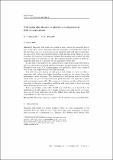Files in this item
Null point distribution in global coronal potential field extrapolations
Item metadata
| dc.contributor.author | Edwards, S.J. | |
| dc.contributor.author | Parnell, C.E. | |
| dc.date.accessioned | 2016-06-29T23:31:17Z | |
| dc.date.available | 2016-06-29T23:31:17Z | |
| dc.date.issued | 2015-07 | |
| dc.identifier | 212699721 | |
| dc.identifier | 3d235c6b-dd1f-490a-a501-38caaa98a556 | |
| dc.identifier | 84939265889 | |
| dc.identifier | 000359738800013 | |
| dc.identifier.citation | Edwards , S J & Parnell , C E 2015 , ' Null point distribution in global coronal potential field extrapolations ' , Solar Physics , vol. 290 , no. 7 , pp. 2055-2076 . https://doi.org/10.1007/s11207-015-0727-7 | en |
| dc.identifier.issn | 0038-0938 | |
| dc.identifier.other | ORCID: /0000-0002-5694-9069/work/73700755 | |
| dc.identifier.uri | https://hdl.handle.net/10023/9063 | |
| dc.description | SJE would like to thank the Isle of Man Government for support during her PhD and also for the financial support of the STFC. | en |
| dc.description.abstract | Magnetic null points are points in space where the magnetic field is zero. Thus, they can be important sites for magnetic reconnection by virtue of the fact that they are weak points in the magnetic field and also because they are associated with topological structures, such as separators, which lie on the boundary between four topologically distinct flux domains and therefore are also locations where reconnection occurs. The number and distribution of nulls in a magnetic field acts as a measure of the complexity of the field. In this article, the numbers and distributions of null points in global potential field extrapolations from high-resolution synoptic magnetograms are examined. Extrapolations from magnetograms obtained with the Michelson Doppler Imager (MDI) are studied in depth and compared with those from high-resolution SOlar Long-time Investigations of the Sun (SOLIS) and Heliospheric Magnetic Imager (HMI). The fall-off in the density of null points with height is found to follow a power law with a slope that differs depending on whether the data are from solar maximum or solar minimum. The distribution of null points with latitude also varies with the cycle as null points form predominantly over quiet-Sun regions and avoid active-region fields. The exception to this rule are the null points that form high in the solar atmosphere, and these null points tend to form over large areas of strong flux in active regions. From case studies of data acquired with the MDI, SOLIS, and HMI, it is found that the distribution of null points is very similar between data sets, except, of course, that there are far fewer nulls observed in the SOLIS data than in the cases from MDI and HMI due to its lower resolution. | |
| dc.format.extent | 22 | |
| dc.format.extent | 4752014 | |
| dc.language.iso | eng | |
| dc.relation.ispartof | Solar Physics | en |
| dc.subject | Magnetic topology | en |
| dc.subject | Magnetic fields | en |
| dc.subject | Global corona | en |
| dc.subject | Potential fields | en |
| dc.subject | QA Mathematics | en |
| dc.subject | NDAS | en |
| dc.subject | BDC | en |
| dc.subject.lcc | QA | en |
| dc.title | Null point distribution in global coronal potential field extrapolations | en |
| dc.type | Journal article | en |
| dc.contributor.institution | University of St Andrews. Applied Mathematics | en |
| dc.identifier.doi | 10.1007/s11207-015-0727-7 | |
| dc.description.status | Peer reviewed | en |
| dc.date.embargoedUntil | 2016-06-30 |
This item appears in the following Collection(s)
Items in the St Andrews Research Repository are protected by copyright, with all rights reserved, unless otherwise indicated.

